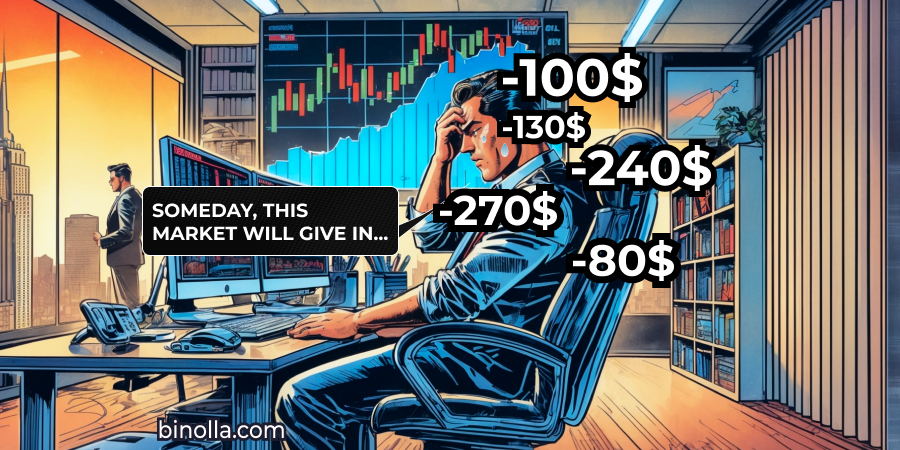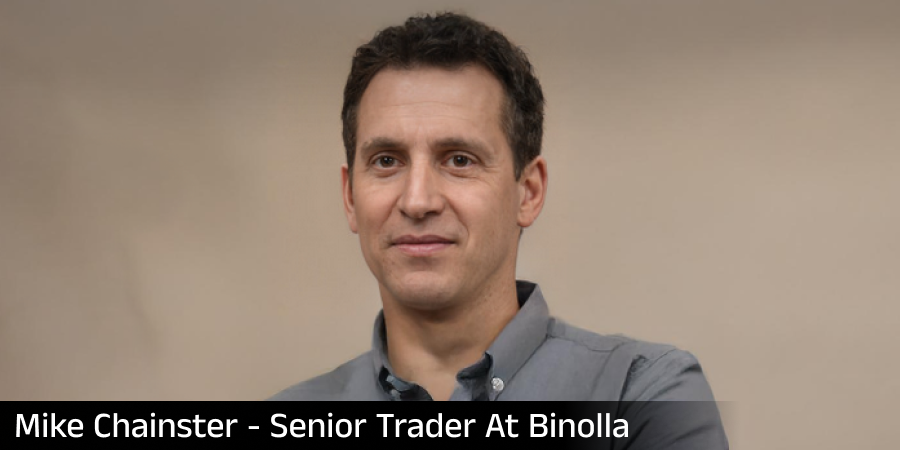10 Ways to Manage Your Risks in Trading
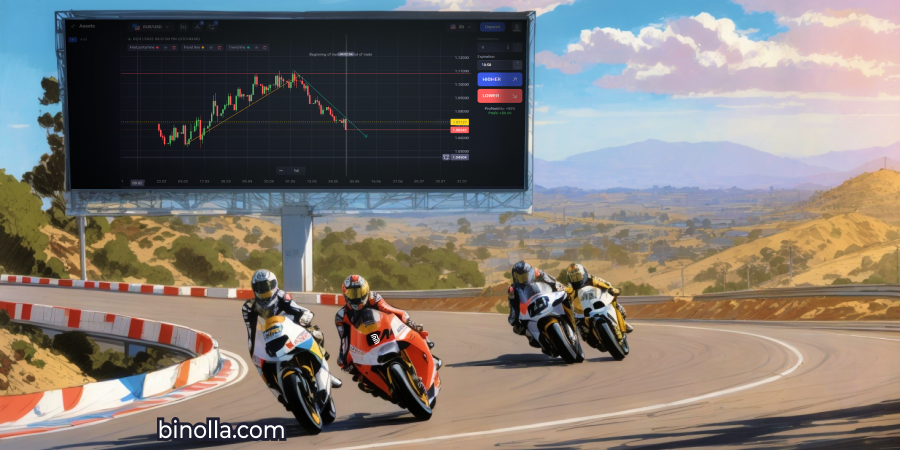
Managing risks is one of the key skills that traders must have in order to be successful in the financial markets. Whatever strategy you have, you put your money at risk. There are several ways you can manage them and, therefore, minimize their impact on your trading. By reading this article, you will learn more about ten ways to manage your risks. Apply these rules when trading with Binolla.
Contents
- 1 1: Types of Risks in Trading
- 2 2: Use Stop Losses
- 3 3: Do Not Risk More Than You Can Afford to Lose
- 4 Start using the best risk management practices now!
- 5 4: Take Profits
- 6 5: Use Your Leverage Wisely
- 7 6: Set Realistic Goals in Trading
- 8 7: Use Trading Plans and Strategies in Trading
- 9 8: Do Not Let Your Emotions Control Your Trading
- 10 9: Test Your Strategies
- 11 10: Review Your Trading Sessions
- 12 Risks Related to Different Underlying Assets
- 13 Final Words
- 14 FAQ
1: Types of Risks in Trading
To be able to manage risks properly, traders should know in advance what they are going to deal with. Here are the key risks that accompany your trading routine:
- Price or market risks. This is one of the most common types of risk in trading. It lies in the fact that the market may perform differently from what you expect from it. Imagine that you think that EUR/USD is trading at 1.0900 and that you expect the currency pair to develop an uptrend. If your idea is wrong, you may lose your investment.
- Leverage risks. When you trade digital options, you can skip this part as you don’t need leverage to buy Higher or Lower contracts. However, for Forex CFDs, leverage is common. This is a kind of credit from the brokerage firm that allows you to increase the size of your positions without investing more. By choosing the wrong approach for picking and using this credit, you risk losing more than you can afford.
- Macroeconomic data risks. Even if you don’t trade news or avoid using fundamental analysis in your daily trading routine, macroeconomic data and central banks’ monetary policy changes are still in the game. Investors should keep an eye on them and act accordingly. If a central bank decides to hike or cut rates unexpectedly, this may have a significant impact on currencies or even stocks.
Now that you know your “enemies,” it is time to learn more about how to manage risks and minimize them in trading.
2: Use Stop Losses

The easiest way to avoid excess risks in trading is to cut them where you can. While you can’t affect macroeconomic data or even the decisions taken by central banks, you can still control the level of risk in each particular trade.
Before going further with stop losses, it should be mentioned that if you are trading only fixed-time contracts, you don’t need this part. Digital options were designed for very beginners, and, therefore, when you trade them, you can’t lose more than a single investment.
Forex CFD traders put their entire deposit amount at risk each time they make a trade. To avoid losing more than they can afford, skilled traders use stop losses.
A stop order is a special order that allows you to set a price level at which the trade will be automatically closed in the event of losses. It helps traders automate routines and allows them to focus on other aspects of trading.
Imagine that you want to buy EUR/USD at 1.0950. You set a stop loss of 1.0940 in order to protect your position. If EUR/USD goes in the opposite direction and hits a stop loss, the position will be closed automatically, and your losses will not exceed those that you have planned in advance.
On the other hand, if you do not set a stop loss order, your losses will further increase if EUR/USD falls below 1.0940.
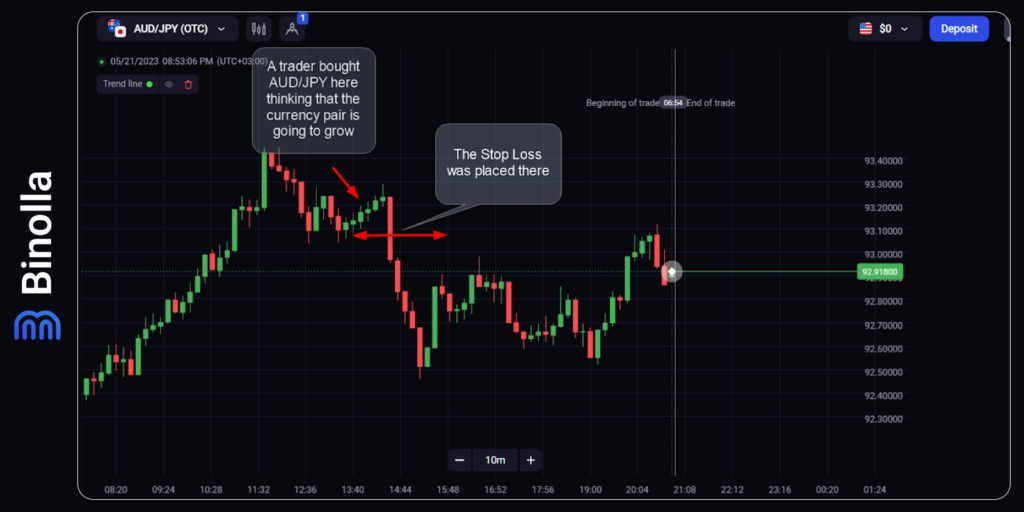
The above image shows an example of how stop losses can save your day. You can see that AUD/JPY has been growing for some time. However, later, it reverses and plunges. The stop-loss order allows you to cut your losses and avoid higher risks.
Stop losses can be used not only to protect you from losses but also to hold your profits if you were right in your forecasts. The idea here is to place this order while your profits are growing. If the price reverses, it hits the stop loss, but you will hold some profits if the trend changes.
Binolla Tip
Stop losses can be applied to all markets except digital options, where risks are predetermined by the nature of the contract.
3: Do Not Risk More Than You Can Afford to Lose
When thinking about trading, you should always keep in mind that it is not only about profits. Losses often occur regardless of what exact financial instrument you use. Both digital options and Forex CFD traders put their money at risk in every trade, which has only two outcomes.
When thinking about the amount that you are going to deposit, you should keep in mind that this sum should be affordable for you. Moreover, in order to be a successful trader and eliminate emotions from your trading routine, you should be prepared for losses, as they are an integral part of trading.
Apart from the deposit amount, traders should also consider the amount that they are willing to put at risk in each trade. There is a general money management rule that suggests that you should not use more than 1-2% of your balance when buying a digital option or buying/selling a currency pair in a Forex CFD. However, this is a general rule that does not take into account a particular asset.
When it comes to fixed-payout contracts, this rule may be applied in any trade, as your profit depends solely on the direction of the price movement. In Forex CFD trading, the situation is the opposite, as the distance that the price covers between the moment when you open a trade and the moment when you close it impacts your payouts directly. Therefore, if you are working with a highly volatile asset, you may consider putting even a smaller amount at risk, while when trading with a “calmer” currency, you may want to increase your position size to seize higher profits.
Increasing the trading amount during the profitable streak will also be a good idea. However, if you have a losing streak, try to decrease your per-trade amount.
Binolla Tip
This recommendation is applicable to all types of financial markets and financial instruments
4: Take Profits

This type of order was designed to protect your profits or automate your trading routine if you expect the price to reach a particular level. Keep in mind that when trading digital options, you don’t need to take any profits at all, as those contracts offer fixed earnings.
For Forex CFD traders, taking profits may be crucial, as they allow market participants to set goals and close trades once the price hits them. In cases of huge volatility, taking profits may become indispensable, as the price may reach a certain level and be rejected in a matter of seconds.
A take profit is similar to a stop loss, but it should be placed on the other side of the trade. Unlike stop losses, take profits are set on the profit side and triggered once the price reaches an expected level.
Stop loss and take profit go hand in hand in most cases. By using them both, Forex CFD traders can properly plan their money and manage their risk. With both orders, traders can set an expected risk/reward ratio and build their strategy around it.
The minimum risk/reward ratio is 1 to 2 in most cases, which means that risking one pip will reward you with two pip. If you set your stop loss at 20 points from the current price, you should set your take profit at a distance that is two times higher.
Binolla Tip:
Take profits can be applied to all types of markets, except digital options. Those contracts are also known as fiex-payout options for offering a predetermined payout.
5: Use Your Leverage Wisely
Leverage is one of the most important aspects of Forex trading. While you don’t need it in fixed-time contracts, when it comes to buying and selling Forex CFD instruments, this credit allows you to have a larger position size and, therefore, expect higher profits (or take severe losses if you are wrong in your forecasts).
Leverage is a kind of credit that the brokerage company gives to its customers so that they can trade at higher volumes. For instance, if your leverage is 1:50, this means that for each $100, you will have $5,000 at your disposal for trading. However, you should keep in mind that if your $100 is lost, your position will be closed at the margin call. Therefore, when using leverage, traders should keep an eye on their balance and manage their money properly.
Binolla Tip
Leverage can be used by Forex CFD traders. As for the digital options, there is no leverage at all.
6: Set Realistic Goals in Trading

Buying digital contracts or trading Forex CFD is all about making profits. All your actions are aimed at this goal. However, you should be realistic with your expectations. Otherwise, you may end up with $0 on your balance and will have to deposit again in order to proceed.
One of the biggest mistakes that both fixed-time contracts and Forex CFD traders make is that they start very aggressively. Beginners sometimes open a lot of trades per day, thinking that this way they are going to have huge profits in a comparatively short time interval. While there is logic behind this concept, such an approach may be very risky and lead to huge losses.
Along with being realistic when setting your trading goals, you should admit when you are wrong. While digital options traders can’t sell their contracts beforehand, Forex CFD traders can cut their losses once they admit that their forecasts failed to come true.
Planning your future profits is also crucial, regardless of what exact financial instrument you use. Both digital options and Forex CFD traders should think about how much they want to earn by the end of a particular period. When setting such goals, you should also be as realistic as possible. For instance, having a strategy with 60% profitability and $100 on your account will unlikely allow you to make $1,000 in the near future.
Binolla Tip
Setting realistic trading goals is a good idea, regardless of what financial instrument you use for trading.
7: Use Trading Plans and Strategies in Trading
A trading plan is what makes the difference between a professional and a beginner trader. Trading on instincts is the wrong way to go and may lead to significant losses. Even though skilled traders have some instincts that help them in their trading routine, they still rely on strategies and trading plans.
An average trading plan should include the following aspects:
- When you buy a contract or buy/sell a currency pair;
- When you exit the market (this is related to Forex CFD only, as when you trade digital options, you will exit the market at expiration);
- Risk/reward ratio. Before getting into trading, it is better to calculate how much you can risk per trade as compared to your eventual rewards (this point is crucial for Forex CFD traders but not for fixed-time contract traders as digital options have a pre-set risk/reward ratio);
- Consider how much you can put at risk in a single trade.
- Think about how much time you can devote to trading and when. A good trading plan includes time intervals in which you will be able to place trades. They, in turn, depend on a couple of factors. First, your trading sessions will depend on the particular asset that you choose. Second, they should also take place when you are free of any of your job and family obligations so that you can focus solely on trading;
- When creating a trading plan, you should have a set of strategies at hand that you are going to use depending on the situation. For instance, if a currency pair is trending, you should use trend-following strategies to succeed, while when there is a reverse, you should apply reversal tactics.
After you have your trading plan, you should stick to it, whatever happens. Keep in mind that it was created without emotions when you were cool-blooded. A trading plan includes all those key aspects that will help you schedule your steps, from finding trading signals to calculating your eventual profits. A good trading plan is similar to a good business plan, and if you have one, you can rely on better trading results.
Binolla Tip
Regardless of what exact financial instrument you use in your everyday trading routine, strategies are important to systematize your trading activities and make consistent profits.
8: Do Not Let Your Emotions Control Your Trading

Staying cool-blooded is one of the main rules in trading because emotions may ruin everything, even if you have a reliable strategy with a high level of profitability. Such feelings as greed, fear, and revenge may prevent you from seeing the whole picture and, thus, making reasonable market decisions.
Emotions may interfere with your trading in many ways. Greed may push you beyond your budget limits and lead to overtrading or putting more money at risk. Instead of trading with 1–2% of your budget, you may step outside those boundaries and put in 10% or even 20%. This is the wrong way to go and may end up costing you a huge share of your trading deposit.
Fear, on the other hand, will prevent you from making reasonable decisions when it’s the right time to trade. After a couple or a series of losing deals, you may be stuck in your feelings instead of thinking about current market opportunities and how to benefit from them.
Another common mistake that traders make emotionally is when they try to take revenge on markets and open positions right after they have had losses. When this happens, you can’t think about proper market analysis. The only thing you want is to get your losses back as soon as possible, and this may lead to improper risk management or even higher losses.
What is really important here is to always stay on guard and try to keep your emotions away from your trading decisions.
Binolla TipKeeping your emotions under control is useful for any financial instrument that you use in your trading activities.
9: Test Your Strategies
In order to understand the profitability of each particular strategy, you should test it beforehand. If you are familiar with some testing tools, you can automate the whole procedure. However, if you don’t have any at hand, you can use so-called “paper testing,” which is a simple usage of a demo mode.
The idea behind this is very simple. You activate a demo mode on the Binolla platform and use your strategy in various situations to see how many positive results you will have compared to negative ones. For instance, you have opened 10 trades with 5 positive outcomes and 5 losses. Therefore, your strategy’s profitability is 50%.
Moreover, by testing a particular strategy, you will also learn more about its features and familiarize yourself with it.
Binolla Tip
Testing strategies is crucial. By doing it, you will be able to know in advance what your exact strategy is capable of. Use this approach when trading any financial instrument.
10: Review Your Trading Sessions
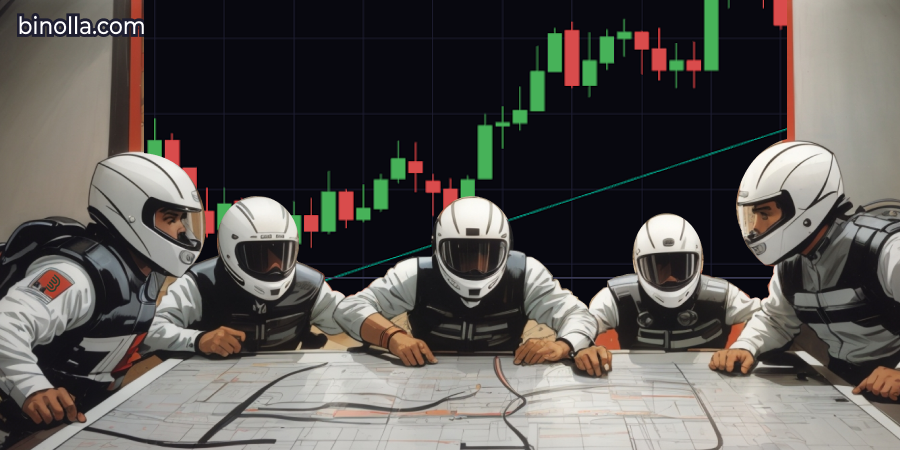
Trading is not entertainment. It is a kind of business, and you should treat it like one. Therefore, to make the most of it, you should review your trading sessions on a constant basis. This will allow you to do your homework and understand where you have made mistakes and how to avoid them in the future.
Reviewing a trading session includes going through your entry points to see where you were wrong and to analyze how to adjust your trading strategy. You can also watch your position sizes to understand whether you trade in compliance with your own money and risk management systems. You can do it regardless of the financial instrument you use. This approach is applicable to digital options, Forex CFD, stocks, and all the others.
When you review your trading sessions, you can reveal common mistakes that you make. Once you see those mistakes, you can make some useful adjustments to your trading strategy so that you won’t make those mistakes in the future.
Risks Related to Different Underlying Assets
While there are general risks that are related to trading, they can also be related to particular underlying assets or financial instruments:
- Forex. Apart from main trading risks that are related to price changes, Forex traders also have risks related to leverage, which is an integral part of Forex trading. Leverage is a kind of credit that a broker gives to a trader so that the latter can have more financial opportunities in trading. However, inappropriate use of leverage will significantly increase your risks. Therefore, you should be careful when choosing and applying particular leverage in trading;
- Stocks. The main risks in stock trading are related to buying shares of a company that is overvalued. When trading stocks, you should research large amounts of data to try to understand whether the company’s stocks are likely to develop an uptrend or are at the point of reverse. One of the successful strategies is to buy blue chips, as they are less volatile and more stable. However, those stocks are unlikely to give you serious price movements for trading. Buying blue chips can be part of your portfolio diversification strategy;
- Commodities. The major risks for commodity prices are supply chain issues or the supersaturation of the market with a particular commodity. If you remember the situation when oil prices were close to zero or even below zero for a while, this is a good example. Therefore, buying such assets as crude oil may be very risky. However, you can add precious metals like gold or silver to your trading or investment portfolio to balance those risks;
- Soft commodities. If you are trading soft commodities like wheat, sugar, or others, your main risks are related to weather conditions. When they are inappropriate, the price of those commodities is likely to grow, while in periods of good, those assets are likely to depreciate;
- Cryptocurrencies. Bitcoin and altcoins are relatively new assets, but they already have their share in the financial markets. The main risks are related to regulation, which still leaves a lot of unanswered questions. Once a new bunch of discussions is launched, BTC and other cryptocurrencies react to it. Moreover, there are plenty of tokens that have real blockchain projects behind them. Depending on those projects’ performances, the price of their tokens will also change.
Final Words
Trading risks are inevitable, and you can’t push them down to zero. However, there are various strategies and recommendations that will help you minimize them to as low levels as possible. By managing your trading risks, you can expect better performance from your trading strategy and higher profits, while your losses will become less frequent and less dangerous to your trading balance.
There are plenty of ways to manage your trading risks, and now, when you have already read the article until this point, you definitely know the most popular recommendations. While using them will help you, you should never stop searching for your own, as it is only up to you to build a successful trading strategy and manage your own risks.
One more recommendation that you can get from us is to never stop learning. Whatever level of experience you currently have, you should continue digging and “swallowing” more knowledge in order to further improve your trading tactics and performance. The problem that many traders face is that they stop learning because they think that they have enough knowledge about financial markets.
FAQ

What is the 1% or 2% Rule in Trading?
According to this rule, you shouldn’t put at risk more than one or two percent of your trading balance in one single trade. However, this is not a strict rule. Sometimes traders use even 5% of their total deposit amount to trade.
What is the Risk/Reward Ratio?
This is one of the money management concepts that allows you to properly calculate your risks and possible rewards per trade. By using a 1:3 risk/reward ratio, for instance, your risk is one pip per three pips of the eventual profit. This approach can be used in Forex CFD or stock trading. When it comes to digital options, you don’t need to calculate your risk/reward ratio, as those contracts have fixed payouts and fixed risks.
Can I Avoid Risks in Trading?
No, you can’t. Risks are an integral part of trading, and the sooner you understand this, the better. Accepting risks in trading is part of your education, as you can’t avoid them at all. However, traders often use various tactics and recommendations to decrease their possible trading risks.
How to Manage Risks in Trading?
There is a whole system that allows you to better manage your risks in trading. It includes four main steps. First, you need to identify your risk. Second, you are to assess it. Next, you need to treat the risk, and the final step is to monitor the risk and how you manage it in your trading routine.

